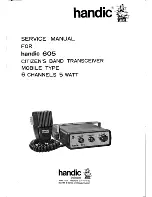
30
MDS iNET Series Reference Manual
05-2806A01, Rev. L
NOTE:
The VLAN Status parameter must be consistent at both Access Point and Remote radios in order
for data to flow correctly. Inconsistent configuration may result in improper data flow and the loss
of over-the-air communications.
Virtual LAN in iNET Series
The iNET-II and iNET support port-based VLAN at the Ethernet interface and over the air, according to the
IEEE 802.1Q standard. A VLAN is a limited broadcast domain, where all members of a VLAN receive
frames sent by any other member of the same VLAN but not frames sent by members of a different VLAN.
When VLAN Status is enabled, the wireless port of both AP and remote radios always acts as a trunk port.
The Ethernet port of an Access Point radio is normally configured as a trunk port. This type of port expects
incoming frames to have a
VLAN ID
and sends outgoing frames with a VLAN structure as well.
• When the Ethernet port of a Remote is configured as a VLAN Access Port, the radio tags incoming
traffic with a
VLAN ID
, and strips the tag before sending out traffic. This VLAN is known as the
DATA
VLAN
. Additionally, a second VLAN is assigned for other traffic that is terminated at the radio, such
as SNMP, TFTP, ICMP, Telnet, etc. This is known as the
MANAGEMENT VLAN
. Traffic directed to
the integrated terminal server that handles the serial ports is assigned to the
DATA VLAN
.
• When the Ethernet port of a remote radio is configured as a VLAN trunk, the radio expects all incom-
ing Ethernet frames to be tagged, and passes through all outgoing frames as received from the wire-
less link, with the unchanged VLAN tag.
NOTE:
The Ethernet port in an iNET-II and iNET is 10BaseT. Some Ethernet switches allow a VLAN
trunk port only on a 100BaseT interface and may not be able to communicate with the radio.
Configuring for Operation with VLAN
When VLAN Status is enabled the radio uses an 802.1Q frame structure.
Invisible place holder
Figure 2-19. Network Interface Configuration Menu
•
VLAN Status
—Defines whether the radio handles Ethernet frames in “extended” 802.1Q mode or in
“normal” mode in the Ethernet port. Ethernet frames intended for the radio, but with a VLAN ID not
configured in the radio are discarded.
[
enabled, disabled; disabled
]
NOTE:
A change made to the above parameter will result in the Commit Changes option appearing on
screen. This will modify the appearance of the screen depending on the option selected.
Summary of Contents for MDS iNET Series
Page 12: ...x MDS iNET Series Reference Manual 05 2806A01 Rev L...
Page 159: ...05 2806A01 Rev L MDS iNET Series Reference Manual 147 Figure A 22 EDS Wizard Completion Screen...
Page 165: ...05 2806A01 Rev L MDS iNET Series Reference Manual 153 NOTES...
Page 166: ...154 MDS iNET Series Reference Manual 05 2806A01 Rev L NOTES...
















































